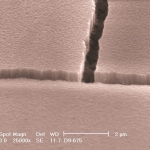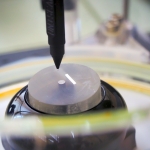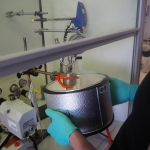Flagship Projects
The Institute essentially develops its activities through collaborative research projects.
These projects:
- Are based on interdisciplinarity
- Prioritise collaborative research and co-development
- Rely on partnerships with all sectors of society (industries, services, research centres, governmental institutions, etc.)
- Bring together provincial, regional, federal, European and international partners.
The Institute is active in setting up research projects, with its partners, which respond to the emerging problems linked to the Institute’s field.
Below you can find a list of some key projects, which highlight some of the issues our researchers tackle.

Portfolio of projects to reduce our dependence on petroleum and its by-products by using biomass and CO2 as new sources for the development of new building blocks, which can be used as basic components for the development of new, innovative and sustainable composite materials.
Development of paint-based lithium-ion batteries for local storage and their integration into the global network for efficient energy management in Wallonia.
The objective of the project is to develop inexpensive humidity and pressure sensors operating at high temperatures and under extreme conditions for the in situ monitoring of concrete to optimise its drying time and make them more efficient. For more information : http://www.cubism-interreg.eu/
Development of communicating microsystems using sensors and low-power electronics.
Development of multifunctional films for biomedicine and biology, the control of environmental contaminations, mechanical actuation, and the recovery of ambient energy.
Implementation of a mobile platform for plasma diagnosis and the modelling of coating growth.
Supramolecular mass spectrometry for the complete structural characterisation of polymer structures and complexes.

The aim of this project is to develop innovative 3D knitted supports for bone reconstruction using polyester yarns, bioceramics and chitosan coatings.

The project aims to combine the advantages of sol-gel technology with the properties of nanomaterials to acquire a solid skills base and develop transparent functionalised coatings. Existing nanomaterials will be used to develop universal functionalisation independent of the particles in order to obtain functionalised, efficient, homogeneous and sustainable coatings.
Materials such as glass and steel are used in the construction, electronics and automotive industries, among others. While there are many sources of dirt that can be seen on glass and steel surfaces, fingerprints are some of the more evident.
Having a solution that avoids or prevents these fingerprints is a matter of major interest for manufacturers active in the field of materials, and for consumers who see it as a real advantage.
The project proposes to transform greenhouse gases (CH4 / CO2) into higher added value molecules of industrial interest using a technology combining plasma and catalysis.
Study using atomistic modelling of the implantation of IONS on the surface of glass in order to modify the surface properties and improve properties such as resistance to corrosion and to bacterial contamination.

Development of nano-oriented biobased resins for aluminium coatings to improve their wear resistance, corrosion protection, electrical and thermal properties, and resistance to aeronautical liquids.
Continuous polylactide acid production by reactive extrusion without an organometallic catalyst.
Creation of a multisensory platform for volatile organic compounds.
The aim of this project is to develop and promote viable and efficient alternatives to hard chromium (hexavalent) deposits for transportation and transformation. As well as raising awareness of the problem, the project also aims to develop and validate 3 types of alterative coatings and to disseminate the research results in industrial circles.
More info on the project website
The project contributes to preserving the environment by synthesising and formulating bio-sourced and biodegradable polyesters (or co-polyesters) that can replace traditional plastics (e.g. plastic bags, water bottles, etc.) as well as plastics in the biomedical field (drug dispensing devices and packaging). This project promotes sustainable chemistry (or green chemistry), an emerging field that supports the design of reactions and processes in a sustainable and environmentally friendly way.
The mission of this European project is to broaden the career prospects of junior researchers, in the academic and industrial sectors, as they work in the economic, environmental and societal field of organic electronics. Supported by the recent scientific breakthroughs of the project partners, the project aims to gain a fundamental understanding of the charge transport mechanisms in molecular semi-conductor systems.
This project focuses on the early diagnosis of lung cancer by analysing volatile organic compounds (VOCs) in exhaled air. The multi-disciplinary consortium contributes significantly to the synthesis of materials which are able to detect VOCs in real-time and can be integrated as sensors into electronic modules.
The aim of this project is to propose optically active textile materials capable of adjusting their infrared reflectance according to temperature or humidity. Two approaches are considered: structuring under self-induced stress and controlling the dispersion of passive or stimulus-active charges.The aim of this project is to propose optically active textile materials capable of adjusting their infrared reflectance according to temperature or humidity. Two approaches are considered: structuring under self-induced stress and controlling the dispersion of passive or stimulus-active charges.
This project aims to develop optical fibres doped with carbon nanomaterials and to use them in a new category of fibre sensors to detect and visualise cancer cells in vivo by achieving unprecedented measurement sensitivity.
Nitrogen fixation is crucial for living organisms. This project aims to exploit cold plasma processes to fix nitrogen by reduction and oxidation in order to gain a thorough understanding of nitrogen fixation mechanisms in N2/O2 and N2/CH4 plasmas and by combining experimental and numerical studies of a wide range of gas and liquid/plasma discharges.
Development of efficient routes for the synthesis and characterisation of monodispersed and stereologically sequence-controlled polymers, comprising structuring groups and functional fragments for the purpose of conferring new or improved functional properties via their 3D structure.
